Back to page 1
The Design
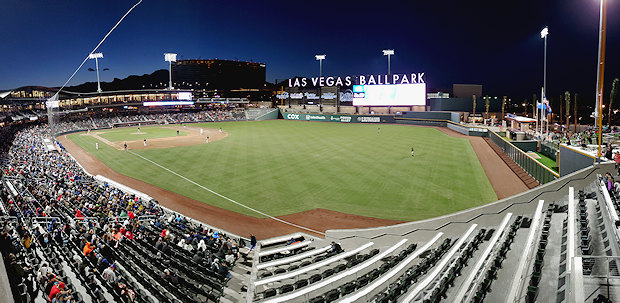
Considering that the groundbreaking for this project was a scant 12 months prior Opening Night on April 9, it’s a miracle that this ambitious of a ballpark was completed in time. In fact, the only aspect of the stadium that was unfinished when the gates opened for the first time was the kids’ splashpad in center field — and considering the cool temperatures and howling wind, there wouldn’t have been any takers had it been open for business anyway.
Everything else, though, was remarkably complete. That’s a testament to the around-the-clock work done by the team from AECOM Hunt and PENTA Construction.
As we venture inside the gates of Las Vegas Ballpark to examine the interior, keep in mind that the team’s nickname is now the Aviators, and that Howard Hughes Corporation (HHC) owns the team and built the ballpark.
“When you walk into the Howard Hughes offices, there’s a big picture of Howard Hughes next to an airplane, in aviators garb,” HOK’s Foss explained. “That foreshadowed what the team’s name would become.
“So the question became ‘How do we relate (the park’s design) to the aviation history of Howard Hughes? How would we do this if this were an airplane, not a building?'”
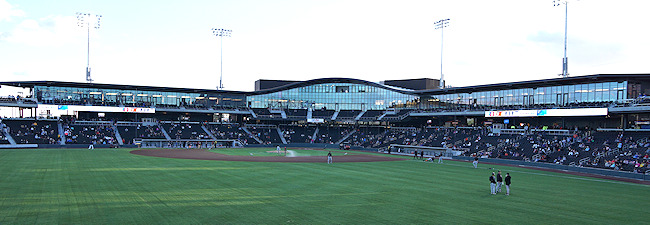 |
| If you use your imagination, you can envision a single-engine fighter plane coming at you. |
The result is a structure that is reminiscent of a World War II fighter plane.
“If you’ve seen the roof, it’s shaped like a single-wing aircraft,” said Foss. “The pressbox becomes the cockpit of the plane.” That curving roofline had to have an “aerodynamic look, one of simplicity and fluidity.”
The wings of this “plane” are rows of luxury suites, 11 on each side. Having that many suites certainly “bucks the trend, but it’s intentional,” noted Foss. “If there’s one thing I’m sure about Don Logan and his team, they know the Vegas market. And I think they’re pretty darn close to leasing all of the suites.”
 |
| The sections closest to the foul poles on both sides feature counter tops with swiveling chairs. |
Most of the seating sections in the park are traditional rows of theater-type seats, again bucking the trend of having suites right behind the backstop or along the concourse. In the corners are sections which are turned toward the infield, but instead of the typical 4TOPP seating (semi-circle-shaped tables surrounded by four swiveling chairs), the team opted for straight drink rails — although the chairs still swivel.
But that’s not the only remarkable thing about the seats at Las Vegas Ballpark.
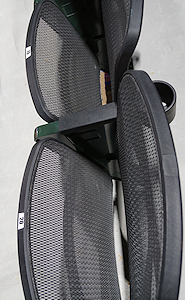 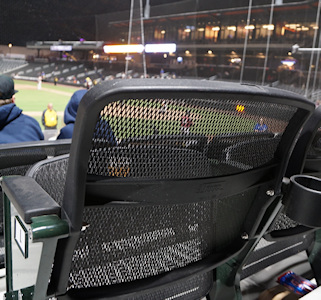 |
| The Braves paved the way when they installed mesh seats in a couple of sections of SunTrust Park. The Aviators have upped the ante (appropriate in Las Vegas) by using mesh in every seat in the ballpark. |
No, every one of the seats in the seating bowl is mesh, not molded vinyl. “We went with Don (Logan) to the Winter Meetings two years ago,” Foss explained. “We sat in every company’s seat. We were so impressed with the fit of the (mesh) seats that we had them install a row of them at Cashman Field for the 2018 season. The people who sat in them loved them, even in July.” Tests show that in hot, sunny weather, the mesh is 30-50 degrees cooler than typical vinyl.
 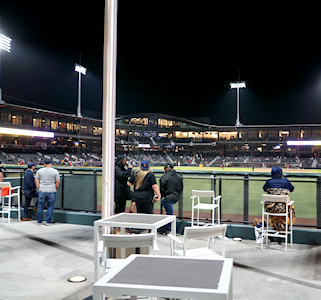 |
| The “social zone” beyond right-center field features great views of the bullpens, room for table games and a splashpad. While only groups can access the swimming pool, anyone with a ticket can use the other spaces here. |
The design of the right-center-field area is well-thought-out. The prettiest swimming pool in the Minors (shown at the top of the first page of this review) is just beyond the outfield fence. It is rented out to groups. There’s The Hangar, which is referred to as the “social zone” by the team, which features a bar that is open to both the pool side and patio side. There’s room for table-top games here, as well as an infield-shaped splashpad and the berm.
 |
| The two-sided bar can be accessed on both the pool side and the social-zone side. |
A noteworthy aspect of the ballpark’s main structure is the number of openings that permit airflow from the outside, across the concourse and through the seating bowl. Even with temperatures that are cooler in Summerlin than at Cashman, it will still be helpful in the summer.
The upper level of Las Vegas Ballpark is, in a word, amazing.
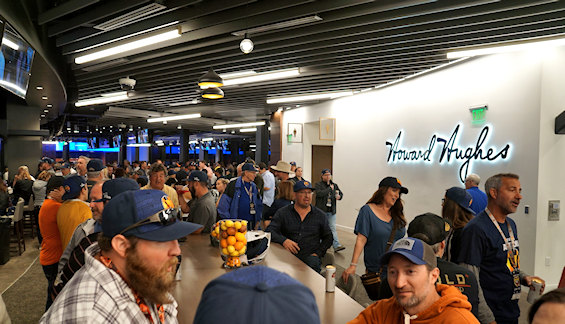 |
| The lounge on the upper level is as nice as at any Minor League park, and rivals most MLB facilities. |
In the center (you know, in the cockpit of the plane-shaped structure) is a mammoth lounge. The one in El Paso’s Southwest University Park is extremely nice, but this might be nicer.
The lounge, which sports the Howard Hughes Corporation’s logo on one wall, features a large bar in the center, various food stations (including a “show” food-prep area where celebrity chefs can demonstrate their talents), and a row of seats with counter tops along the glass. There may be plans to swap out some of that glass with NanaWalls that can be slid open. That would come in handy when the space is being used for a wedding reception or meeting on a nice day.
 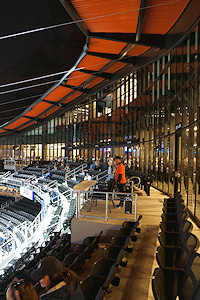 |
| The views from the Club Level are the best in the park. And you have to love the orange. |
The club seats in front of the lounge have a spectacular view of the field. The positioning and pitch of the rows are perfect. And having the attractive orange on the underside of the roof overhead is a really nice touch.
While watching the game from this level, you really notice how immense the netting is between the field and the seats. Not only do the nets extend all the way to the far ends of the dugouts, they are extremely high. Foss explained that there are several reasons for this (to protect the club seats, the suites and the streets that run next to the park), but the main reason is structural, because the support cables attach to the roof.
The height of the screens also causes the lights from the infield light towers to reflect off of them — making them more noticeable at night when you are trying to look through them to watch the game. Foss said there are screens made of clear material, but they really reflect light, so they were rejected.
| Taking off |
 |
| The architects at HOK, headed by Principal Anton Foss, worked hard to incorporate elements of aviation into the ballpark. “When you’re in center field looking toward the infield,” said Foss, “you’ll always know you’re in the Las Vegas Ballpark.” |
Directly over the lounge is the pressbox. Most new parks have shoved the press area down one of the foul lines. Not here, thankfully. It is high over home plate … although the pole that supports the center of the roof does cut off the view of the field for a couple of unlucky writers. The view from the broadcast booths is exceptional, though.
It was important to Don Logan that the pressbox be on its own level. “We were at the All Star Game in Durham and the pressbox is right behind the fans there. Some of the fans got drunk and were yelling so that it could be heard on the broadcast. I thought, ‘If we ever get to build our own park, we’re going to separate the press from the patrons.'”
As you would expect, the suites are gorgeous. The decorating and furnishings are as nice as I’ve seen in the Minors, and unlike in Amarillo’s new park, there is seating in front (as opposed to the flat “patio” arrangement at Hodgetown).
The very best aspect of the upper level might be the areas farthest from home plate. At each end of the level are party decks. Not only are they significantly larger than the decks at other Minor League parks, the views from them are unrivaled.
“Honestly, we were always trying to find places where we could capture views,” Foss said, “but I didn’t know that it was going to be as good as it was until I saw it for myself.”
He pointed out that the deck down the third-base line allows you to see the twinkling lights of the Las Vegas Strip in the distance. On the first-base side, you see the mountains with the Red Rocks behind the ballpark. See the photo below.
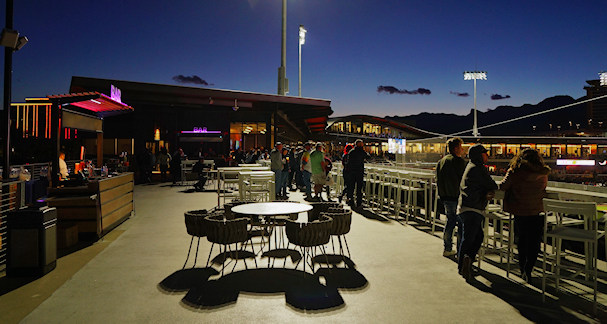 |
| The first-base party deck is quite large and the views of the sun setting over the mountains are stellar. This is one of my very favorite spots in the park, and it really takes advantage of seeing colors “of the earth and of the sky.” |
When I asked Logan what was on his shopping list when the design process was starting for this park, he said, “Shade. I always wanted a pool. All the good parks have a kids area. You have to have 360-degree circulation.” Interesting that all of these were deficiencies at Cashman, and they’ve all be rectified in Summerlin.
With such a nice design, does the gameday experience measure up?
The Essentials

When the Howard Hughes Corporation is involved in any endeavor, you can count on everything being done in a first-class way. Such is true of the gameday experience — although one minor aspect does detract from it a little bit.
Let’s start with the most impressive element of attending a game at Las Vegas Ballpark: hospitality.
This is Las Vegas after all, so just like the casinos are likely to have someone with the title Hospitality Experience Curator on staff, you shouldn’t be surprised that the Aviators have one, too.
Her name is Sarah Camarota.
| The Curator |
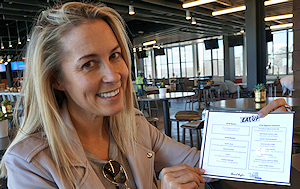 |
| Sarah Camarota shows off the laminated card that all 350 staff members must have with them at all times. “It provides the mantra, the mindset and the mission that every person who interacts with guests is going to have.” |
She is an accomplished local restaurateur in her own right, as a partner in three restaurants on the Vegas Strip. She was hired as a consultant by HHC to oversee the implementation of the food-and-drink experience at the new park. Her passion for the job and her ability to articulate HHC’s mission are obvious from the first minute you meet her.
“I came at this as three things: a baseball mom whose family will spend time here; as someone who has been involved in sports and entertainment for a long time; and as a Strip-level restaurateur,” she explains. And she isn’t just applying her skills to the well-heeled suite holders. She wants to impact all aspects of the experience of each person who walks through the gates.
“All of it. Absolutely all of it. Look, if I were going to get a celebrity chef to create one dish for 100 VIPs in the Club, that doesn’t really move the needle. But if I say we’re going to tackle the hot dog and do it better than anybody else, at a great price, for everybody here, that starts to move the needle.
“We designed all of this with all fans in mind.”
Take the hot dog, “the most iconic, most important food in baseball” she calls it. She organized a “taste team” that sampled a dozen different dogs and a slew of buns. The winning combination is a Kosher dog from Hebrew National in a locally produced potato bun.
Local restaurants were brought in to provide foods for several of the stands on the main concourse. In so doing, “you’re tapping into people’s hometown pride,” Camarota said. Me Gusta Taco operates a stand on the first-base side that features three kinds of taco meats, beef, chicken and pork of course. You get two tacos with chips for $11.
Local chef Josh Clark of The Goodwich created a “build your own mac & cheese” stand on the third-base side, where you can select a topping and two garnishes for $10.
The Home Run BBQ stand in center field provides a Mexican twist to BBQ, with Burnt End Burritos and a bowl with smoked tofu (photo below). Both are $14.
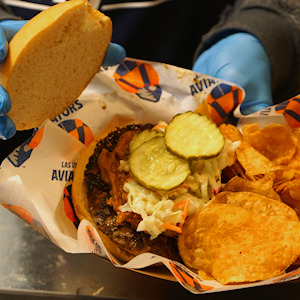 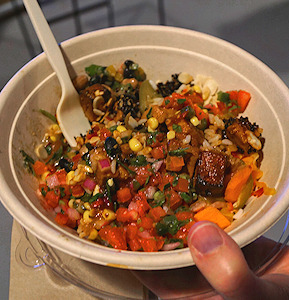 |
| I wolfed down the Mt. Charleston burger ($14), which was excellent. The Smoked Tofu Bowl at the Home Run BBQ stand is also $14. |
The Flight Deck Burger Grill on the first-base side features the All American bacon cheeseburger and Mt. Charleston (photo above), which is a half-pound patty, pulled pork, coleslaw, pickles and BBQ sauce, all piled on a bun. Both are served with chips for $14.
Whether you’re eating at your seat on the field level or upstairs in one of the premium areas, your food is served with “pride and passion,” says Camarota. She quickly adds that every staff member is to “understand that they are in the world’s most beautiful ballpark serving happy fans delicious food that we’ve worked really hard to make wonderful.
“For every aspect of the hospitality experience, we asked ourselves one simple question: is it best in class?” she continued. “This applies to the food, of course, and also the uniforms, menu boards, signage (and) service training. Every fan touch-point has been meticulously crafted to elevate the experience for our customers.”
Camarota summarized her philosophy this way: “Our bold approach is just right for Las Vegas. I think what we have achieved is a ballpark that acts like a vibrant social food hall and community hub, and it needs to continue to evolve with the community. From a business standpoint, that is our big opportunity.”
Which mirrors what I said earlier: HHC figures out the best way to do something, and then the financial results follow.
Speaking of financials, what does it cost to attend an Aviators game? As mentioned earlier, the parking is free. As for tickets, most of the seats from one end of the dugout all the way around to the end of the other are sold out as season tickets. That means that you’re likely looking at Outfield Prime seats just beyond the dugouts for $18 and the Outfield Box sections well down the lines, $15. General admission tickets, which allow you to watch the game from the berm or The Hangar social zone, are $12.
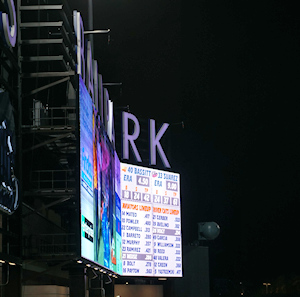 You may see upward movement in these prices for games with especially high demand. “We are going to do some dynamic pricing. We have to,” noted Logan.
You may see upward movement in these prices for games with especially high demand. “We are going to do some dynamic pricing. We have to,” noted Logan.
Are these prices higher than comparable seats at other Triple-A parks or, for that matter, at Cashman Field? Yes, but you’re likely to have a better experience at Las Vegas Ballpark than elsewhere — and unquestionably better than at Cashman.
The video board is a stunning 31′ tall and 126′ wide — making it the largest below the Major League level. As Logan likes to add, “It’s also the best in the Minors because it’s 13 mm high def.”
Further, the video screen has a unique vertical bend — that architects call a “cant” — toward its center field end (see the photo). This bend occurs directly above the angle between the very straight left-field wall and the equally straight center-field wall. This cant in the scoreboard, says Foss, “helps the intimacy factor, and keeps your eyes from wandering off into the hinterlands.”
The sound system is equally impressive. No matter where you are in the park, you’ll hear the PA announcer and music clearly.
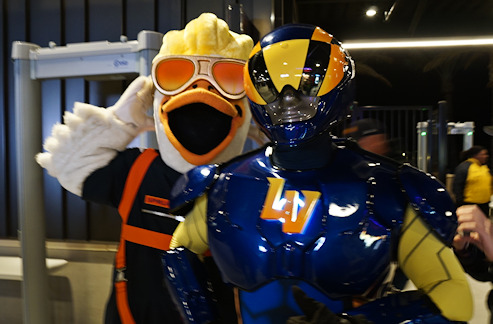 |
| There are two very different mascots for the Aviators, probably to appeal to two different audiences: Spruce the Goose and The Aviator. |
The staffing — ushers, security guards, etc. — is remarkable, reflecting HHC’s approach to customer service. A number of fans told me that they were pleasantly surprised at the large number of helpful folks working there.
And what about the aspect of the gameday experience that doesn’t measure up? It’s the merchandise.
With a total rebranding of the franchise, a new $100 million ballpark and two new, marketable mascots, I expected to see the same level of awesomeness in the souvenir shop as at the concession stands and by the ushers.
The team store, which is on the first-base concourse and can be accessed on non-game days from the outside plaza, is of sufficient size (2,000 square feet of retail space), but it’s arranged in a way that makes it challenging to shop, and worse, the variety in merchandise just wasn’t there.
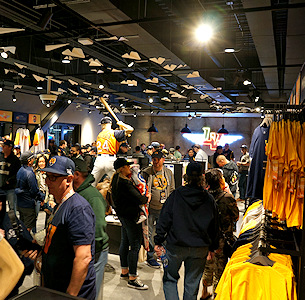  |
| The team shop doesn’t offer the selection that I’m seeing at other new parks. The prices fit in with other costs at the park: most men’s and women’s t-shirts are $28, and $18-$28 for kids. Adjustable caps are $22-$32, while fitted caps are a pricey $38. |
Was I peeved that they didn’t have my favorite souvenir item (lapel pins) in stock? Yes, but this goes well beyond that. With a new team nickname and logo, there should’ve been dozens of varieties of shirts and caps, especially for kids — and definitely at an operation owned by HHC. Compared to what I’d seen the day before at the opening of Amarillo’s new Double-A ballpark (where the store is only 1,450 square feet), the Aviators seemed to offer a poorer selection even though they are a Triple-A franchise.
This isn’t like a wall was constructed in the wrong place. This is easily fixable. It’s a matter of creating and ordering colorful apparel and souvenir items in lots of variations — especially for children. Oh, and get lapel pins in stock!
Does this mar the gameday experience horribly? No. But it’s an area where the Aviators can improve.
It’s perhaps the only area where they need to improve! That’s because the overall experience delivered at Las Vegas Ballpark is extremely strong.
Summary
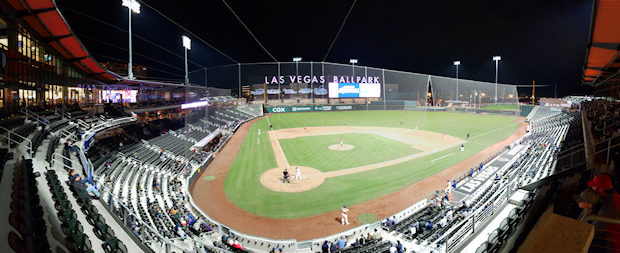
Don Logan likes to say that the new facility in Summerlin “is a Major League ballpark that only happens to have 8,500 seats.”
When asked to elaborate, he provided a list: “The different destinations within the ballpark. The location. The (mesh) seats. The Pool. The Club. The Party Decks. The Suites. One of the best scoreboards in baseball. The sound system. Yes, it’s a Major League ballpark.”
| End of a long wait |
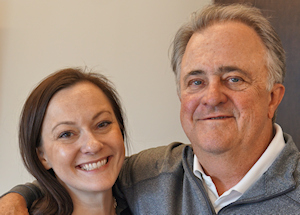 |
| Don Logan has been with Las Vegas’ franchise longer than his delightful daughter Adrienne has been alive. After many years of trying, they finally have a new ballpark. |
In many regards, it’s far nicer than your average big-league stadium.
Making this possible is the entity that owns the Aviators. “Howard Hughes is the right owner. They have the financial wherewithal to do this right. We didn’t have any ‘value engineering’ here.” In case you’re not familiar with the phrase, value engineering refers to the cuts made during the construction process to bring the overall project within the budget. It happens all the time when ballparks are being built, when the cost of a design feature ends up being higher than anticipated. For example, instead of a pressbox being on an upper level, it’s moved down to the concourse. Think Stockton, Reno and Charleston, WV.
It’s fair to ask where this park ranks in all of the Minors.
Pat O’Conner, the President of Minor League Baseball, attended the openers in Amarillo and Las Vegas on consecutive days (as did I). In Summerlin, he told me, “From the player amenities to the fan amenities and everything else, I’ve not seen anything that rivals this. No doubt, the ballpark in Amarillo will serve the people of that community for a long, long time, but this place raises the bar for all of baseball.”
My favorite Triple-A parks have long been Columbus, El Paso and Charlotte. Many would add Memphis. But I think Las Vegas Ballpark is among this group, if not topping all of them.
“I don’t mean this to be a boast,” Logan remarked as we were wrapping up the interview, “but we’re doing things that have never been done in Minor League Baseball.”
Have thoughts about this review or Las Vegas Ballpark? Use the comments area below.
Great article on this park.
Unless I missed it, is there any mass transportation to the park?
How far from the big casinos?
Thanks for the compliment! I mentioned that RTC (which operates mass transit throughout the metro area) has a bus stop right in front of the ballpark’s main gates. Also, it’s only a 20 minute drive from Downtown Summerlin to the middle of the Las Vegas Strip where Bellagio and Caesars Palace are located — as long as you don’t try to do it at rush hour.
What did you think about the field? (Not the stadium, but the field itself)
The playing surface in Summerlin looked really good. No flaws. I’d just been at Amarillo’s opener the night before, and their field was NOT pretty — lots a yellow and thin spots. That’s because the weather recently in the Texas Panhandle hasn’t been conducive to the growing of grass. Las Vegas hadn’t had the same problem. Over the coming weeks, the grass in Amarillo will be just fine, though.
Great review Joe! Good seeing you in Summerlin and thanks for the unofficial tour at the ballpark!
Always great to see a fellow ballpark chaser! Thanks for the kind words.
Been trying without success to find out about ballpark policies. Specifically what you can or can’t bring into the stadium. Bags, water, food?
I found the list on a separate website, not on the Aviators’ site: https://www.thelvballpark.com/prohibited-items
Very nice article about our new stadium in Vegas. A few points, Summerlin is NOT a separate municipality, so it is wrong to call it a suburb of Las Vegas. All of Summerlin has Las Vegas mailing addresses. Additionally, I’m not sure if you noticed this during your visit, but I was rather put off by the fact that there is no good view of the LV skyline. From that area of town, the High Roller, Stratosphere, and the Luxor are all visible to the east, yet the building in RF completely blocks the view. I’m sure that was done intentionally as part of HHC’s attempt to use the team and park as an advertisement for Summerlin.
Also, lapel pins are in stock. As a fellow collector, I’d be happy to pick one up for you.
Thanks for your compliment, Matt. I concede your point about my use of the term “suburb,” as half of Summerlin is within Las Vegas city limits and the other half (including where the ballpark is located) uses a Vegas zip code. I disagree that HHC and the architects chose the location for the food-prep building simply to block fans’ view. If you look at the ground floor of that building, you’ll see huge bays where large trucks make deliveries. It really couldn’t have been anywhere else. There is a spot in the ballpark that has a fantastic view of the Strip, though, but most fans can’t access it because it’s the party deck on the LF end of the upper level. And I’m glad lapel pins are finally in stock, but that store has a long way to go before I would call its selection of merchandise good. The other three ballparks that have opened this year all have much greater selections — and what’s for sale in the store in Class-A Fayetteville dwarfs what’s in the Triple-A shop in Summerlin. Other than the store, though, I really loved the Aviators’ new park.
I heard a story that the elevation of the park is equal to the top of the stratosphere tower– any truth to this?
According to Google, the top of the Stratosphere is 1,149 feet above street level. Las Vegas Ballpark is a little over 3,000 feet above sea level, while the part of Vegas where Cashman Field sits is just under 2,000 feet above sea level. So that would make the top of the Stratosphere about equivalent in elevation to the new ballpark. Good question!
Great article, Joe. The park sounds like a true wonder. I am the PA announcer for the Triple-A Chihuahuas in El Paso, so I dont get a lot of chances to travel during the regular season, but hope I can make it to Vegas to take in a game sometime in the near future.
Well done job with this article…thorough and comprehensive. I live in New York & am a Mets fan (who formerly owned the Las Vegas team as you probably know) and after reading this, I almost want to go to Summerlin & Vegas to see this gem of a ballpark. So, what officially would you call Summerlin in relation to Vegas: I know it’s NOT a suburb, is it a section of town or more like a borough like in NYC? Thanks.
Thanks for your kind comments. The ballpark was a pleasure to write about because it’s both beautiful and incredible. Regarding how to classify Summerlin … I think all of NYC’s boroughs are considered to be in New York City, right? Half of Summerlin, though, is within the city limits of Las Vegas, and the rest is in unincorporated Clark County — but still carries a Las Vegas mailing address! The generic term “suburb” still seems to fit to me.